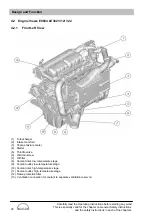
General Safety Instructions
17
Carefully read the Operating Instructions before starting any work!
This is especially valid for the chapter on General Safety Instructions
and the safety instructions in each of the chapters.
2.7
Specific Dangers
The following section describes residual risks which have been identified.
S
Observe the safety instructions listed here and the warnings in the other chapters of these instructions
in order to reduce health hazards and avoid dangerous situations.
Electrical Current
DANGER!
Risk of death caused by electrical current!
There is a risk of death when coming into contact with parts conducting electrical currents.
Damaged insulation or components can be life threatening.
For this reason:
S
If the insulation is damaged, immediately switch off the power supply and get the insula
tion repaired.
S
Any work performed on the electrical system may only be made by a qualified electrician.
S
When working on the electrical system the power supply must be switched off and then
properly checked to ensure no electrical current is present.
S
Before starting any maintenance, cleaning or repair work the power supply must be
switched off and secured from being accidentally switched back on.
S
Do not bridge or bypass any fuses. When replacing fuses, ensure to use the correct am
perage.
S
Keep moisture clear of parts conducting electrical current. This could cause a short-cir
cuit.
DANGER!
Risk of death caused by electrical current!
Do not touch or pull on the following parts of the ignition system when the engine is in oper
ation:
S
Ignition coils and caps
S
Wires of the high voltage circuit
S
Wires of the low voltage circuit
S
Connectors of the output and input wires
Moving Parts
WARNING!
Risk of injury caused by moving parts!
Rotating or linear moving parts can cause serious injuries.
For this reason:
S
During operation do not reach into or tamper with moving parts.
S
Do not open the covers during operation.
S
Observe the run-on time: before opening any covers ensure that no parts are still moving.
S
Wear close-fitting clothing in the hazard area.
















































